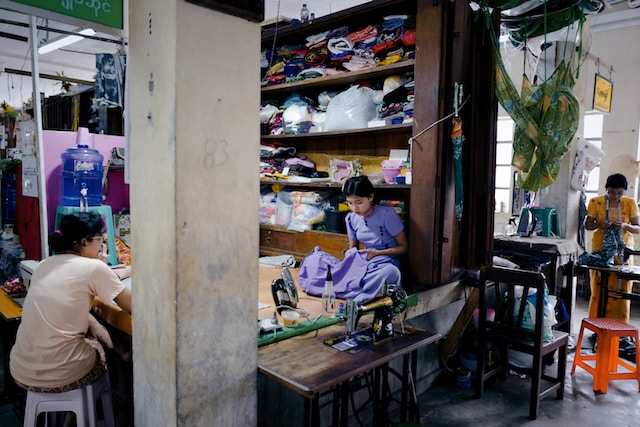In today’s fast-paced world, the fashion industry is notorious for its rapid production and consumption of clothing, known as fast fashion. While it may be tempting to indulge in the latest trends, it is crucial to understand the negative impacts that fast fashion has on the environment and society. From excessive waste and pollution to unfair labor practices, this article explores the detrimental consequences of fast fashion and aims to raise awareness about the importance of making more sustainable and ethical choices when it comes to our clothing.
Environmental Impact
Textile waste and pollution
Fast fashion’s rapid production and consumption cycles have led to a staggering amount of textile waste and pollution. With the relentless demand for trendy clothes, the fashion industry is producing more garments than ever before. Sadly, a significant portion of these clothes ends up in landfills or incinerators, contributing to environmental degradation. The synthetic fibers used in fast fashion clothing, such as polyester, are non-biodegradable and can take up to 200 years to decompose. As these fibers break down, they release harmful microplastics into the environment, polluting our oceans and endangering marine life.
Water consumption
The fashion industry is notoriously water-intensive, with the production of a single cotton t-shirt requiring approximately 2,700 liters of water. This enormous demand for water has severe consequences, especially in regions already experiencing water scarcity. Fast fashion’s reliance on cheap labor in countries like Bangladesh and India further exacerbates the problem, as these countries often have limited access to clean water. The excessive water consumption of the fashion industry not only depletes freshwater sources but also contributes to water pollution due to the release of untreated wastewater containing harmful chemicals.
Chemical use
Chemical usage is widespread in fast fashion production, from dyeing fabrics to treating garments for wrinkle resistance and flame retardancy. However, the majority of these chemicals are hazardous to both human health and the environment. Toxic dyes used in the textile industry can contaminate water bodies, harming aquatic life and posing risks to human health when absorbed through the skin. Moreover, the use of chemicals such as formaldehyde in garment finishing can cause allergies, skin irritations, and respiratory problems for both factory workers and consumers.
Deforestation
The fashion industry’s reliance on natural fibers like cotton contributes to deforestation on a massive scale. Forests are cleared to make way for cotton plantations, disrupting delicate ecosystems and releasing large amounts of carbon dioxide into the atmosphere. Deforestation not only exacerbates climate change but also destroys habitats and threatens biodiversity. Additionally, the fashion industry’s demand for wood-based fabrics, like rayon and viscose, further drives deforestation as trees are harvested to produce these materials. The loss of forests has far-reaching consequences for the environment, including soil erosion, increased greenhouse gas emissions, and the loss of natural resources.
Labor Exploitation
Poor working conditions
Fast fashion brands often outsource their production to countries with lax labor laws, enabling them to cut costs and maximize profits. As a result, garment workers face abysmal working conditions that violate basic human rights. These workers endure long hours, cramped and unsafe factories, inadequate ventilation, and lack of access to clean water and sanitation facilities. The pressure to meet unrealistic production targets leads to physical and mental exhaustion, contributing to workplace accidents and health issues. The exploitative nature of fast fashion disregards the dignity and well-being of the workers, perpetuating a cycle of poverty and inequality.
Low wages
One of the most significant issues in the fast fashion industry is the prevalence of extremely low wages for garment workers. Many workers earn wages that are well below the local living wage, barely enough to cover their basic needs. These meager wages make it impossible for workers to escape the cycle of poverty, trapping them in exploitative working conditions for years on end. Some workers, particularly women, are even subjected to wage theft, where their rightful earnings are withheld by unscrupulous employers. The lack of fair wages perpetuates economic inequality and strips workers of their rights and dignity.
Child labor and forced labor
Fast fashion’s insatiable demand for cheap and fast production has created an environment conducive to child labor and forced labor. In countries where labor regulations are weak or poorly enforced, children are often employed in garment factories to meet production deadlines. These children are robbed of their childhood, forced into hazardous working conditions, and deprived of education. Similarly, forced labor is prevalent in the fashion industry, with vulnerable individuals coerced into working against their will. The exploitation of children and forced labor not only violates basic human rights but also perpetuates poverty and denies individuals the opportunity to break the cycle of exploitation.

Waste and Resource Depletion
Overproduction and excessive consumption
Fast fashion promotes a culture of overproduction and excessive consumption, contributing to the global problem of waste. Constantly changing trends and the pressure to stay fashionable lead to a mindset of disposable clothing. Consumers buy clothes that quickly fall out of style, only to discard them after a few wears. This cycle of overproduction and consumption creates an enormous amount of waste that overwhelms landfills and incinerators. Moreover, the resources used to produce these garments, such as energy, water, and raw materials, are rapidly depleted, further degrading the environment.
Throwaway culture
The rise of fast fashion has ushered in a throwaway culture where clothes are treated as disposable commodities. Instead of valuing quality and durability, consumers are enticed by low-cost, trendy garments that are designed to be worn a few times and then discarded. This throwaway mentality has devastating consequences for the environment, as landfills overflow with discarded clothing items that take years to decompose. The energy and resources used to produce these garments are squandered, contributing to resource depletion and environmental degradation on a large scale.
Loss of natural resources
The fashion industry’s reliance on natural resources, such as water, land, and raw materials, puts immense pressure on the environment. The cultivation of cotton, for example, requires vast amounts of water and agricultural land, leading to soil erosion and degradation. Additionally, the extraction of oil for synthetic fibers depletes fossil fuel reserves and contributes to greenhouse gas emissions. The fast fashion model perpetuates the unsustainable use of natural resources, with little regard for the finite nature of these resources and the long-term impact on ecosystems.
Social and Cultural Implications
Homogenization of culture
Fast fashion’s global reach has led to the homogenization of culture, eroding traditional clothing practices and diversity. As fast fashion brands flood the market with cheap and mass-produced garments, traditional clothing styles and craftsmanship are pushed aside. Indigenous communities and local artisans who rely on their unique cultural heritage to sustain themselves face immense challenges in the face of fast fashion’s dominance. The loss of traditional clothing practices not only erodes cultural diversity but also strips communities of their identity and economic opportunities.
Negative body image and self-esteem
Fast fashion’s emphasis on constantly changing trends and unrealistic beauty standards has a profound impact on body image and self-esteem. The unattainable ideals perpetuated by the industry contribute to low self-esteem, body dissatisfaction, and a negative body image among consumers. The pressure to conform to these standards can lead to detrimental physical and mental health consequences, including eating disorders and anxiety. Fast fashion’s promotion of a narrow and unattainable ideal of beauty fosters an environment that undermines individual well-being and self-acceptance.
Copycat culture
Fast fashion thrives on the rapid replication of designer or high-end fashion trends, often at a fraction of the cost. This copycat culture not only devalues original and innovative designs but also fuels an environment of disregard for intellectual property rights. Local designers and independent artists struggle to compete with the fast fashion industry’s ability to quickly mimic popular trends, stifling creativity and innovation. The prevalence of copycat culture not only harms original designers but also perpetuates an industry built on imitation rather than authenticity and craftsmanship.

Impact on Local Economies
Undermining local artisans and businesses
The rise of fast fashion has had a detrimental impact on local artisans and businesses that rely on traditional craftsmanship and unique designs. As fast fashion brands flood the market with cheap and mass-produced garments, local artisans struggle to compete, often facing economic decline and job loss. The unique skills and craftsmanship that have been passed down through generations are undervalued and overshadowed. The undermining of local artisans not only harms local economies but also erodes cultural diversity and diminishes the value of craftsmanship.
Displacement of traditional skills and crafts
The dominance of fast fashion is causing the displacement of traditional skills and crafts that have been honed over centuries. As mass-produced clothing becomes more readily available and affordable, there is less demand for handmade, artisanal products. This shift in demand leads to the loss of traditional skills and knowledge, leaving communities vulnerable to economic instability and cultural erosion. The disappearance of traditional skills not only robs communities of their cultural heritage but also limits future generations’ opportunities to carry on the unique crafts and cultural practices.
Loss of cultural heritage
As fast fashion continues to globalize and dominate the market, the loss of cultural heritage becomes a significant concern. Traditional clothing practices, weaving techniques, and unique designs that are integral to a community’s cultural identity are at risk of disappearing. The fast fashion industry’s focus on speed and cost-efficiency leaves little room for the preservation and celebration of cultural heritage. The loss of cultural heritage not only weakens communities’ sense of identity but also deprives the world of diverse and rich cultural expressions.
Economic Inequality
Fast fashion’s contribution to wealth disparity
Fast fashion’s business model relies on exploiting cheap labor from low-income countries while maximizing profits in wealthier markets. This global supply chain perpetuates economic inequality by concentrating wealth in the hands of fast fashion brands and perpetuating poverty in the countries where production takes place. The low wages and exploitative working conditions prevalent in the industry not only trap workers in a cycle of poverty but also contribute to wealth disparity on a global scale. Fast fashion’s profit-driven approach prioritizes the interests of a few at the expense of the many.
Monopolization of the industry
The fast fashion industry is becoming increasingly monopolized, with a few major conglomerates controlling a significant share of the market. This monopolization not only limits competition but also consolidates power within a few hands. As these conglomerates gain more control over the industry, they dictate trends, production practices, and labor conditions, leaving little room for transparency, ethical practices, and fair competition. The monopolization of the fashion industry marginalizes smaller, independent brands and stifles innovation, further perpetuating economic inequality and limiting consumer choice.
Health Risks

Toxic chemicals in clothing
The use of toxic chemicals in the textile production process poses health risks to both factory workers and consumers. Harmful dyes, finishes, and treatments contain chemicals such as lead, formaldehyde, and phthalates, which are known to be carcinogenic or have adverse effects on human health. Factory workers in poorly regulated countries often lack protective equipment and are exposed to these toxic chemicals daily, leading to serious health issues. Consumers, too, face risks as the chemicals can be absorbed through the skin, leading to allergies, skin irritations, and long-term health concerns.
Skin allergies and irritation
Fast fashion’s reliance on synthetic fibers and cheap manufacturing processes can lead to skin allergies and irritations in consumers. Synthetic fabrics like polyester and nylon are often treated with chemicals to enhance their properties or increase durability. These chemicals, along with residues from the manufacturing process, can irritate sensitive skin and cause allergic reactions. Moreover, the low-quality production methods used by fast fashion brands can result in poor construction, rough seams, and uncomfortable fits, further exacerbating skin irritation and discomfort for those wearing the garments.
Microplastic pollution
The proliferation of fast fashion and its reliance on synthetic fibers contribute significantly to microplastic pollution. When synthetic garments are washed, they shed tiny fibers known as microplastics that end up in water bodies. These microplastics are then ingested by marine life, entering the food chain and posing potential risks to both aquatic ecosystems and human health. As the fashion industry continues to produce and sell synthetic garments at an alarming rate, the volume of microplastic pollution continues to skyrocket, emphasizing the urgent need for sustainable alternatives and responsible waste management.
Animal Cruelty
Fur and leather production
Fast fashion’s demand for fur and leather products perpetuates immense cruelty towards animals. In the pursuit of luxurious materials, millions of animals, including foxes, minks, rabbits, and cows, are subjected to intense confinement, painful handling, and brutal killing methods. The fur industry, in particular, often raises animals in confined spaces devoid of natural behaviors, leading to significant suffering. The production of leather involves harsh chemicals and waste disposal processes that harm the environment and endanger the health of workers. The fashion industry’s continued reliance on these materials disregards animal welfare and supports a cycle of cruelty.
Animal testing
The fast fashion industry’s use of chemicals and finishes often involves animal testing to assess the safety of these substances. Animals, such as rabbits and mice, are subjected to painful and often lethal tests to determine the potential adverse effects of these chemicals. The use of animals in experiments is not only cruel but also unnecessary, as there are alternative methods available that don’t involve animal suffering. The fashion industry’s utilization of animal testing perpetuates unnecessary harm to animals and highlights the need for cruelty-free and ethical practices.
Environmental harm to habitats
The fashion industry’s impact on animal habitats extends beyond the use of fur and leather. The extraction of raw materials like cotton and viscose, as well as the pollution caused by textile production, harms ecosystems and endangers wildlife. Pesticides used in cotton cultivation contaminate soil and water bodies, affecting the biodiversity of surrounding habitats. Similarly, the release of untreated wastewater and chemicals from textile factories into rivers and oceans disrupts fragile ecosystems and puts aquatic life at risk. The fast fashion industry’s practices contribute to the destruction of habitats and the loss of biodiversity worldwide.
Climate Change
Carbon emissions from production and transportation
The fast fashion industry is a significant contributor to carbon emissions, primarily through the production and transportation of garments. The energy-intensive processes involved in textile production, such as spinning, weaving, dyeing, and finishing, release substantial amounts of greenhouse gases. Additionally, the transportation of garments from manufacturing facilities to retail stores and eventually to consumers results in further carbon emissions. The reliance on fossil fuels, especially in countries with coal-powered plants, exacerbates the carbon footprint of the fashion industry. The carbon emissions from fast fashion significantly contribute to climate change, exacerbating its impacts on the planet.
Increased greenhouse gas emissions
The production and disposal of fast fashion garments significantly increase greenhouse gas emissions that contribute to climate change. As previously mentioned, the energy-intensive processes involved in textile production release vast amounts of carbon dioxide and other greenhouse gases. Furthermore, the decomposition of synthetic fibers in landfills produces methane, a potent greenhouse gas that is far more harmful than carbon dioxide. The throwaway culture promoted by fast fashion results in frequent disposal of garments, exacerbating the emission of greenhouse gases and speeding up climate change. Urgent action is needed to reduce the fashion industry’s carbon footprint and mitigate its contribution to global warming.
Long-Term Consequences
Impacts on future generations
The negative impacts of fast fashion have far-reaching consequences for future generations. The degradation of the environment, exploitation of natural resources, and perpetuation of social inequality create a world that is increasingly challenging to navigate for future generations. The loss of biodiversity, contamination of water sources, and climate change will pose significant challenges for the generations that come after us, requiring them to address the consequences of our actions today. The fashion industry must adopt sustainable practices to ensure a better future for future generations, where the environment is preserved, and social equity is prioritized.
Irreversible damage to ecosystems
Fast fashion’s relentless pursuit of profit and disregard for the environment is causing irreversible damage to ecosystems worldwide. The depletion of natural resources, deforestation, pollution of water bodies, and loss of habitats have lasting consequences for the delicate balance of ecosystems. Once damaged, ecosystems may be unable to recover fully, leading to the loss of plant and animal species, disruption of vital ecological processes, and diminished resilience to climate change. The irreversible damage caused by the fashion industry poses a significant threat to the Earth’s biodiversity and further exacerbates the global environmental crisis we face.
In conclusion, the negative impacts of fast fashion are vast and varied, affecting the environment, labor conditions, social fabric, economies, and even our own health. The fashion industry’s emphasis on fast, cheap production and consumption has severe consequences that cannot be ignored. It is imperative that we, as consumers, make conscious choices to support sustainable and ethical fashion practices. By demanding transparency, supporting brands that prioritize environmental and social responsibility, and embracing a slower, more mindful approach to fashion, we can contribute to a more sustainable and equitable future.












